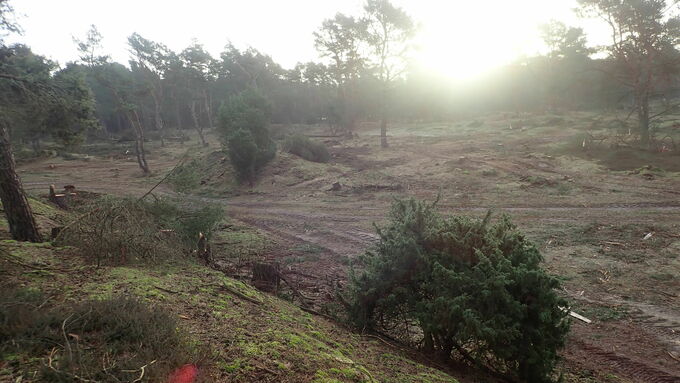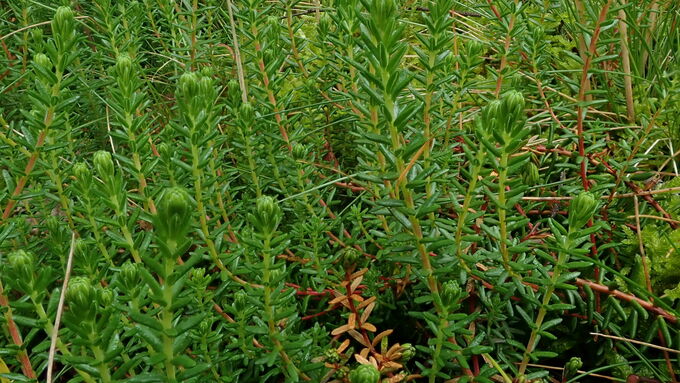The open land character now predominates on the area. Single standels were marked with warning tape and left standing. © Leonie Braasch, NLWKN
download picturemain content
Project of the month
#02/2024 Habitat types 2320 and 2330
Brought to light: Dry sand heaths with Calluna and Empetrum nigrum in the nature reserve ‘Itterbecker Heide’
The nature reserve ‘Itterbecker Heide’ in the west of the County of Bentheim was placed under protection back in 1939 and has also been designated as SAC. Old aerial photographs bear witness to the much more open sand heaths of that time. In addition to the dry sand heaths (habitat type 4030), inland dunes are hidden on areas that at first glance appear to be normal pine forest. The special feature of the inland dunes is the growth of crowberry and grey hair-grass and bent grass - these are two rare habitat types (2320 and 2330) that are protected under EU law. Around one sixth of the total area of habitat type 2320 in Lower Saxony is located in the ‘Itterbecker Heide’! Unfortunately, shading, scrub encroachment and grass encroachment as well as invasive species are increasingly causing problems for both habitat types, meaning that they are now in a poor conservation status.
In 2016, the district's lower nature conservation authority therefore responded to the first call of the LIFE IP ‘Atlantic Region DE’ and an initial action was jointly implemented in the winter of 2018/2019. This was primarily possible because the nature conservation foundation of the district had purchased the area meanwhile as part of the ‘Joint Task for the Improvement of Agricultural Structures and Coastal Protection’ in Lower Saxony with its funding for non-productive, investment-based nature conservation. Land acquisition is one of the central instruments of the nature conservation foundation in order to support the state and the district in accordance with the foundation's purpose in the performance of sovereign tasks such as the management of protected areas.
The action focused on creating clearings, removing topsoil, mowing the crowberry heath and combating black cherry on an area of around 6 hectares. A pine bar was removed to connect the area with the dry heath. A positive side effect of the action was the creation of larger areas for breeding sites for the endangered nightjar, another inhabitant of the ‘Itterbecker Heide’. The female nightjars lay their eggs on the sandy ground in areas with little vegetation.
The subsequent management plan for the SAC emphasized the positive effects of the action. Nevertheless, the situation was not yet optimal: a mapping study had still classified the adverse effects being too high. As the crowberry had tolerated the clearing well, the focus was now placed on a larger scale and the original open land character with few trees was targeted. Additional support in planning the action came from the relatively new Ecological Station ‘Grafschaft Bentheim - Emsland Süd’ (ÖGE). With combined forces, the tender for the extensive clearing and removal of black cherry and cultivated blueberry, including their roots, was initiated in 2023 and the action was finally implemented. ÖGE took over the supervision of the measures, which this time were carried out on an area of almost 8.5 hectares. Individual gnarled trees were left standing to provide some shade for the crowberries. Pines, black cherries and cultivated blueberries were removed from the area and utilized where possible. Sod transplants of crowberry with the excavator were also tested so that the species as a root creeper can spread further into the area. A further expansion to areas that are not currently addressed as a habitat type was rejected for the time being. A large amount of topsoil would have to be removed for this and the exact development of the area would be unclear.
All parties involved are now eager to see how the open land area will develop in the future. The essential follow-up management is to be financed in the form of grazing with sheep and goats via agri-environmental measures.
Verwandte Themen
- Habitat type 2320 – Dry sand heaths with Calluna and Empetrum nigrum (in German)
- Habitat type 2330 – Inland dunes with open Corynephorus and Agrostis grasslands (in German)
- Overall objectives of the project
Weitere Links
- Old aerial photographs of the County of Bentheim (external link opens in a new window)
- Implementation notes for habitat type 2320 - Niedersächsischer Landesbetrieb für Wasserwirtschaft, Küsten- und Naturschutz (in German) (external link opens in a new window)
- Implementation notes for habitat type 2330 - Niedersächsischer Landesbetrieb für Wasserwirtschaft, Küsten- und Naturschutz (in German) (external link opens in a new window)
- District Grafschaft Bentheim (in German) (external link opens in a new window)





